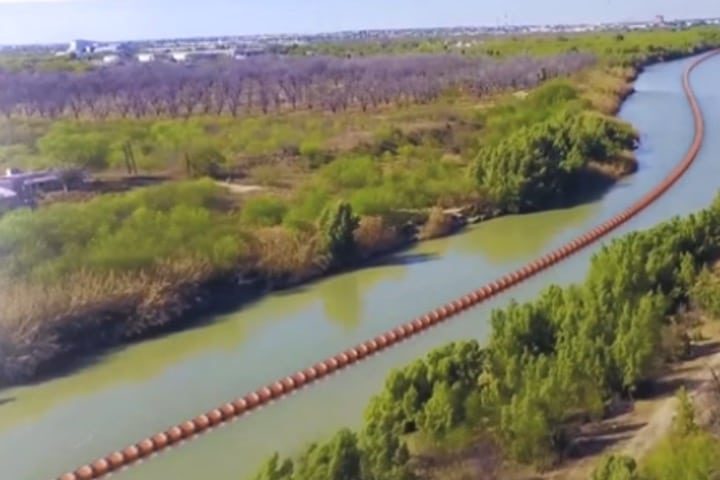
Texas Governor Greg Abbott signed a package of six bills on border security into law on Thursday at the state Capitol. According to a press release, the new legislation “will expand Texas’ unprecedented efforts to hold the line and protect Texans from the record level of illegal immigration, weapons, and deadly drugs pouring into Texas from Mexico caused by President Biden’s refusal to secure the border.”
During the bill signing ceremony, Governor Abbott declared:
Thanks to the leadership and hard work of Director McCraw, General Suelzer, and their teams, Texas has pushed back against the swell of migrants and held the line to keep people out of Texas—but there’s more that needs to be done,” said Governor Abbott. “The Texas Legislature has stepped up to make sure we continue to robustly respond to President Biden’s growing border crisis, including allocating $5.1 billion for border security. Today, I am signing six bills from this year’s regular session to ensure that Texas can continue to do even more to stop illegal immigration at our southern border and provide new tools to the brave men and women along the southern border to protect Texans and Americans from the chaos and crisis of the border.
In addition to the new border security laws, Abbott also announced the installation of floating barriers to deter illegal crossings in hot spots along the Rio Grande River. The press release shared that “this strategy will proactively prevent illegal crossings between ports of entry by making it more difficult to cross the Rio Grande and reach the Texas side of the southern border.”
During the press conference, sample images of the crossing barrier were presented, showing large orange buoys held together by a cable and anchored in the riverbed. The first 1,000 feet of the river barrier will be deployed near Eagle Pass, which is a busy crossing point for illegal aliens.
“What we’re doing right now, we’re securing the border at the border,” Abbott said during his presentation. “What these buoys will allow us to do is to prevent people from even getting to the border.”
The Washington Post shared that “the Border Patrol’s Del Rio Sector, where Eagle Pass is located, has become one of the deadliest places along the U.S. southern border. Migrants are routinely swept away by powerful river currents, and more than 200 deaths were recorded in the sector between 2017 and 2021, the latest year for which U.S. Customs and Border Protection statistics are available.”
Along with the floating buoys, there will be an attached screen that goes into the water and is anchored to the bottom so people cannot swim underneath.
According to the Post, “some hydrologists and engineers have warned about the environmental risks of placing large floating objects with cables into the middle of a dynamic river channel, noting they are likely to clog with debris. If the anchor system fails or the cable were to be severed by smugglers with power tools, the unmoored barrier could create a downstream hazard.”
Rolando Salinas Jr., mayor of Eagle Pass, Texas, a city near where the barrier will be placed, welcomed Abbott’s plan, saying, “If this means less people will be crossing illegally through the heart of Eagle Pass, we support it,” reported The New York Times.
However, there are others who think that Abbott is playing with people’s lives while using the announced barrier as a political stunt. CBS News reported:
The Texas chapter of the League of United Latin Americans Citizens condemned Abbott’s plan. State Director Rodolfo Rosales denounced it as an inhumane, barbaric and ill-conceived plan. Rosales said the organization stands against any measure that could lead to a loss of migrant life, but did not specify what dangers the organization felt the buoy barrier could pose.
“We view it as a chilling reminder of the extreme measures used throughout history by elected leaders against those they do not regard as human beings, seeking only to exterminate them, regardless of the means employed. It is with profound horror and shame that we bear witness to the consideration of these measures, which are evidently intended as political theatre but will undoubtedly result in the loss of innocent lives among the refugees seeking asylum in the United States.”
Here’s a summary of the $5.1 billion Texas border security legislation:
- Legalizes the use of drones for search and recovery missions after natural disasters and for monitoring the Texas-Mexico border as part of Operation Lone Star.
- Creates a grant program to compensate agricultural landowners up to $75,000 for property damage caused by trespassers committing a border crime, such as the smuggling of persons, evading arrest, human trafficking, or a drug offense.
- Authorizes the governor to coordinate and execute an interstate compact for border security among interested states without congressional approval.
- Expands the authority of U.S. Border Patrol agents who have completed a DPS training program to include arrest, search, and seizure at established border checkpoints and points of entry for felony offenses under Texas law.
- Designates Mexican drug cartels and criminal organizations as foreign terrorist organizations in the state of Texas and increases penalties for the destruction of illegal drugs and the operation of stash houses. This bill also adds foreign terrorist organizations to current intelligence databases and allows local entities to seek public nuisance claims against them.
To learn more about the border crisis and what to do about it, click here.




